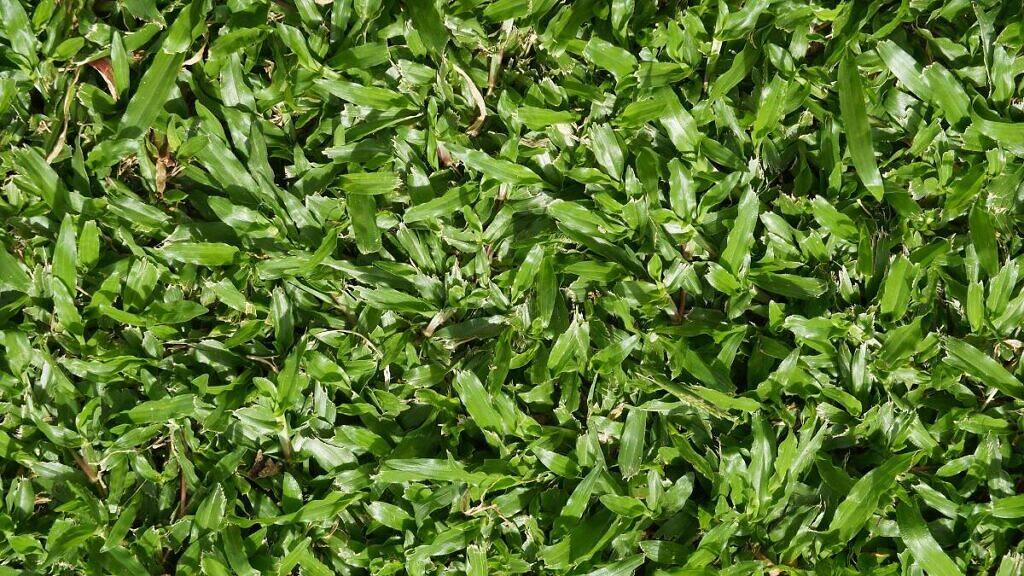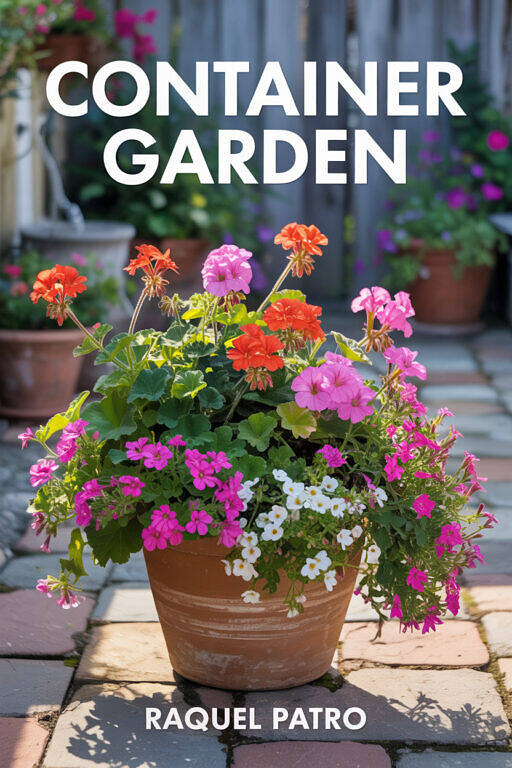Tropical Carpet Grass (Axonopus compressus), also known as Southern Carpet Grass or Broadleaf Carpet Grass, is a species of perennial grass widely used in landscaping projects, residential gardens, parks, and institutional areas due to its dense texture, broad leaves, and intense green color. It is notable for its ability to form compact and uniform mats, and it tolerates light foot traffic, partial shade, and moist or low-fertility soils. Its hardiness and ease of maintenance make it a popular choice in tropical and subtropical regions of South America, Central America, Australia, Asia, and parts of Africa. Beyond its ornamental value, it is used as pasture, for erosion control, and as groundcover under fruit trees or in orchards, where generally other grass species do not thrive.
The scientific name Axonopus compressus originates from the Greek “axon” (axis) and “pous” (foot), referring to the digitate shape of the inflorescences that branch from a common point on the stem. The specific epithet “compressus“, from Latin, means “compressed”, alluding to the flattened aspect of the culms or leaf sheath.
Native to the Americas, Tropical Carpet Grass naturally occurs from the southern United States to Argentina, including the Caribbean, Central America, the Amazon basin, and tropical regions of South America. Its typical habitat includes wet savanna areas, forest clearings, watercourse edges, and open fields with acidic to moderately fertile soils. It adapts well to subhumid or humid environments, tolerating altitudes from sea level to about 9,842 feet (3,000 meters) in tropical mountainous regions. Outside the American continent, it has been successfully introduced in countries of West Africa, Southeast Asia, and Oceania for ornamental or forage use. It prefers sandy to clayey soils with good moisture and shows vigorous growth at temperatures between 66°F and 86°F (19°C and 30°C).

Axonopus compressus is a low-growing, perennial herbaceous grass. In ideal conditions, it forms dense mats that rarely exceed 6 inches (15 cm) in height, although the floral stems can reach up to 18–20 inches (45–50 cm). The root system is fibrous and shallow, with stoloniferous rhizomes that spread horizontally and root at the nodes, promoting rapid soil coverage. The stems are thin, laterally compressed, light to medium green in color, generally less than 0.12 inches (3 mm) in diameter, and have a smooth texture. The growth is predominantly stoloniferous, with short branching and the formation of pubescent nodes along the stolons.
The leaves of Tropical Carpet Grass are broad for a grass species, lanceolate, flat, and arranged alternately along the stolons. They feature a deep dark green color with well-defined parallel veins; the edges are entire and may have slight pilosity on the leaf sheath. The length of the blades ranges from 2 to 6 inches (5 to 15 cm) and the width from 0.12 to 0.63 inches (3 to 16 mm). The leaves are persistent throughout the year in suitable environments. The texture is soft to the touch, with no pronounced shine on the adaxial surface and generally without significant pubescence on the blade.
Axonopus compressus is a monoecious species, featuring bisexual flowers in its inflorescences. Flowering mainly occurs during the warm and humid seasons of the year. The inflorescences consist of two to four slender spikes that emerge from the axil of the upper leaf; each spike measures 2 to 4 inches (5 to 10 cm) in length and is predominantly light green or slightly purplish in color. The flowers are small, elliptical, sessile, arranged in flattened spikelets with bilateral symmetry. Pollination is anemophilous (carried out by the wind). The fruit is an elliptical, brown-yellowish caryopsis, about 0.05 inches (1.25 mm) long, with no ornamental value. The seeds are small, smooth, and numerous per plant, mainly dispersed by wind or by adhering to moist soil.
Tropical Carpet Grass has several recognized types, distinguished by characteristics of adaptability, hardiness, and application in different contexts. Among these, we can mention:
- Axonopus compressus var. compressus: the most commonly available type, featuring broad leaves, soft texture, and high turf density.
- Axonopus compressus var. australis: adapted to subtropical regions, notable for its resistance to mild temperatures and moderate frost tolerance.
- Axonopus compressus var. itirapinensis: a regional Brazilian variety, known for its hardiness and good performance in acidic soils.
- Axonopus compressus var. jesuiticus: native to southern Brazil and Argentina, with high resistance to foot traffic.
- Axonopus compressus var. macropodius: broader leaves than the common type, recommended for low-maintenance areas.
Despite its commercial name, Carpet Grass Plus is a selected cultivar of Axonopus fissifolius (formerly A. compressus var. affinis). Commercially, this cultivar presents significant differences compared to Axonopus compressus, which has broader and hairier leaves and thrives better in partially shaded and moist soils. In contrast, Carpet Grass Plus (Axonopus fissifolius) offers similarly wide leaf blades without hairs, greater turf firmness, good tolerance to foot traffic, and better adaptation to warm climates—qualities that make it ideal for high-use lawns such as public parks and recreational areas.

Tropical Carpet Grass has a remarkable ability to adapt to different tropical and subtropical environments, surviving from sea level to altitudes over 7,546 feet (2,300 meters). Moreover, studies indicate that its leaf extract has significant antioxidant properties, explored in research with therapeutic potential. The species also plays a crucial role in the biological control of erosion and slope stabilization in humid regions or areas prone to intense flash floods.
In landscaping, Tropical Carpet Grass is widely used as a lawn for residential gardens, condominiums, and public parks due to its soft texture, bright, intense foliage, and tolerance to light trampling. Its ability to form dense mats hinders the establishment of invasive plants and provides visual uniformity as ground cover, creating unity and connecting different sections of the garden. It is also frequently used under orchards or ornamental trees due to its good adaptation to partial shade and moist or poorly drained soils. It is recommended to associate it with shrubby species or small trees that provide partial shade, such as jaboticaba trees (Plinia cauliflora) or ornamental palms.
It is important to consider that its use is not recommended in areas with more than one stress factor. If used as ground cover in shaded areas, it should not be subjected to trampling, and vice versa. Tropical Carpet Grass primarily acts as a filling species in functional landscaping. Its predominant function is to cover large areas to protect the soil against surface erosion, which is why it is also recommended for the protection of slopes and inclines, combined with species with deeper root systems that help stabilize the soil. In sustainable projects, it stands out for its contribution to soil biodiversity and ease of integration with regional native species. It can be used in sports lawns and playgrounds, provided they are private, with low frequency of use, offering excellent comfort and softness.

Tropical Carpet Grass shows high adaptability to different light conditions, developing well in full sun, partial shade, and even under filtered light. It is suitable for regions with tropical and humid subtropical climates, tolerating average temperatures between 66°F (19°C) and 86°F (30°C), with moderate resistance to thermal variations. It withstands episodes of cold and light frost, but may show temporary yellowing of the leaves under prolonged low temperatures. It is not sensitive to maritime conditions, although other grass species are more recommended for coastal areas. In high altitudes, it maintains good performance as long as there is no persistent intense cold.
It grows in clayey to sandy soils, with good moisture retention and adequate drainage, tolerating heavy or low fertility soils. The ideal pH ranges from 5.0 to 6.5, and it is important to avoid alkaline soils to prevent foliar chlorosis. Irrigation should be regular, keeping the soil consistently moist without waterlogging; Tropical Carpet Grass tolerates temporary waterlogging but is sensitive to prolonged drought. It is recommended to use good quality, low salinity water, as the species does not tolerate saline soils or waters. During hot and dry periods, increase the frequency of watering to maintain the lawn’s vigor.
Planting should be done in soil that has been previously leveled, with corrected pH and free of debris, clods, or weeds; sods should be laid immediately after delivery, positioned side by side without spacing to ensure rapid lawn closure. Initial fertilization can be omitted in fertile soils, but chemical analysis is recommended for correction with organic matter or fertilizers rich in nitrogen, phosphorus, and iron when necessary; annual repetitions in spring and fall promote greater leaf density.

Regular pruning should be done whenever the Tropical Carpet Grass reaches a height of about 2–3 inches (5–7 cm), removing no more than one-third of the leaf blade at a time. The application of mulch helps maintain moisture, soil fertility, and control of invasive plants. The use of lawn mowers with leaf recyclers, which shred and drop the leaves as close to the ground as possible, is beneficial for immediately replenishing this organic matter during mowing. When using standard mowers, it is preferable to clean up the residues after pruning to maintain the aesthetic appearance and prevent surface fermentation. Avoid cutting the grass with a brush cutter, which can leave the grass very low, and promote pests, diseases, and weeds, as well as generally weaken the grass.
Although it is a common practice, the application of soil over Axonopus compressus, especially in winter when the plant reduces its vegetative growth, is not recommended. This practice, despite being traditional, promotes the emergence of weeds, reduces the light reaching the leaves, impairing photosynthesis, and can carry pests and diseases to the lawn. Instead, the correct approach is the application of topdressing, a thin layer of sand mixed with organic matter, preferably ground peat, during the late spring, without covering the grass leaves. Proper coverage promotes the growth and resilience of Tropical Carpet Grass, enhancing its aesthetic appearance and its ability to regrow after being trampled.
Axonopus compressus exhibits high competitiveness against weeds and good tolerance to most typical lawn pests. However, it can be affected by infestations of pasture spittlebugs (Deois flavopicta), which suck the sap and cause widespread yellowing, especially during warm and rainy periods. It is also susceptible to attacks by caterpillars (such as Spodoptera spp.) and the presence of leaf-cutter ants, particularly in less urbanized areas.

Among fungal diseases, leaf spots caused by Rhizoctonia solani and mildew stand out, which mainly occur when there is an excess of nitrogen fertilizer and high humidity. Despite this, the ruggedness of the species makes it less susceptible to severe damage, including herbivory by domestic animals. Proper management, with regular mowing, balanced fertilization, and good drainage, combined with periodic monitoring, is essential for early detection and control of phytosanitary issues.
Propagation is preferably carried out by dividing the clumps or separating the rooted stolons, a technique that ensures rapid establishment of the lawn; planting by seeds is possible, but less efficient due to slow growth rate. For vegetative multiplication, separate segments with well-formed roots during spring or early summer, replanting immediately in prepared moist soil. Rooting occurs quickly under ideal conditions of temperature and humidity, allowing the vegetative mat to close within a few weeks after planting the plugs or sod.


